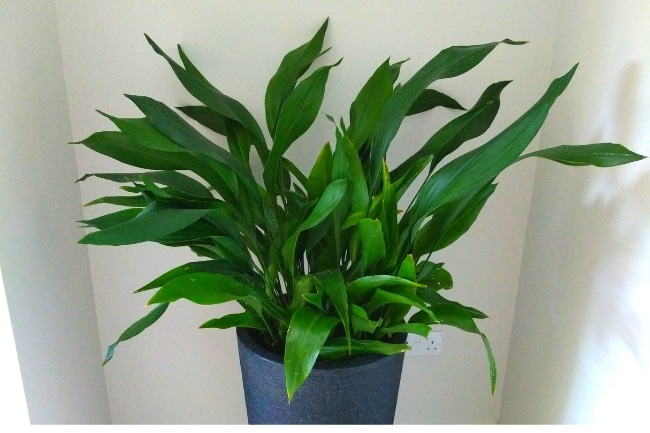Originating from deep in the forests of Japan and China, Aspidistra Elatior or as it’s often referred to, the Cast Iron Plant, is ideal for anyone looking for a low maintenance houseplant. This elegant, hardy plant thrives where many other house plants struggle. This article will teach you all you need to know about Cast Iron plant care, to keep yours thriving year after year.
Appearance
The plant itself comes from the Asparagacae family. As a slow-growing perennial, it can grow upwards to 50 to 70 cm in height. It boasts dark green leaves, which erupt directly from an underground rhizome on long stalks. The leaves arch outwards from the center of the plant, elegantly curving, displaying the beautiful foliage.
Growing Your Aspidistra Elatior Or Cast Iron Plant
This is the ideal plant for anyone who has a “brown thumb”. It requires little care and is easy to tend to. The dark green leaves are healthy and robust and will tolerate low indoor lighting.
If you’re like many indoor plant owners and forget to water it occasionally, this plant is very forgiving. It will reach a mature height of approximately 2 feet which makes it ideal as a floor plant or a tabletop plant.
The Cast Iron plant will develop a number of new leaves each year, and the plant will slowly extend outwards, reaching a maximum spread of about 3 feet. Even with careful nurturing, it is a slow-growing plant, so should provide you with many years of enjoyment.
The Cast Iron plant is ideal for anyone who cannot always find the time or remember to give their plants the attention they need. This plant will survive when other plants would shrivel up and die.
Cast Iron Plant Care Summary
| Scientific Name | Aspidistra elatior |
| Origin | Japan and Taiwan |
| Light Requirements | Does best in moderate to bright, indirect lighting. Cast Iron plants will tolerate low lighting very well, although they will grow more slowly and the leaves will typically be smaller and darker green. |
| Watering | Wait until the top half of the soil feels dry to the touch, then water thoroughly. Consistent overwatering, or leaving your Cast Iron plant in soggy soil will cause root rot. Underwatering can cause brown leaf tips, but otherwise, it is very tolerant of underwatering. |
| Soil | Any well-draining potting mix will be suitable for your Cast Iron plant. Consider adding some perlite, pumice, or coarse sand to a houseplant potting mix to improve drainage. |
| Temperature | Does best in temperatures of 60-80°F (15.5-27°C). Cast Iron plants can tolerate temperature a little above and below this range, but try to avoid hot or cold drafts. |
| Fertilizer | I use a balanced, water-soluble fertilizer every 4 weeks during spring and summer. Overfertilizing will cause brown leaf tips and seriously impact the health of your plant. |
| Humidity | Cast Iron plants prefer moderate to high humidity, but tolerate low hu midity very well. |
| Flowering | Rarely flowers indoors. The purple flowers form at soil level and aren’t very impressive. |
| Pruning | Remove damaged foliage as required, and prune to maintain the plant’s size. |
| Propagation | Cast Iron plants can be propagated by division when repotting. Simply divide the rhizome into two or more pieces and pot these separately. |
| Re-Potting | Does not need to be repotted more than once every few years. The rhizome will continue to expand outwards over time, enlarging the size of the plant. You can increase the pot size when repotting, or prune the plant to maintain its size.. |
| Diseases and Pests | Quite resistant to both pests and diseases. Can suffer fungal or bacterial leaf blotch diseases if overwatered. Scale, mealybugs or spider mites can sometimes cause issues. |
| Toxicity | Non-toxic to humans and animals. |
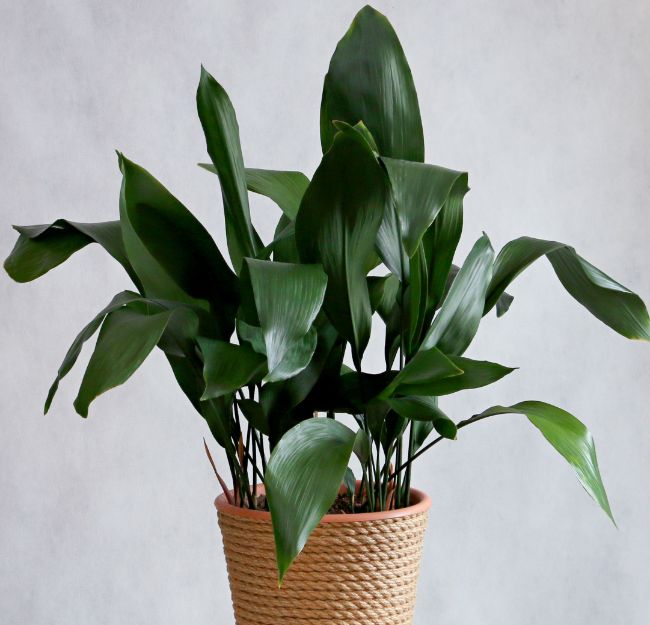
Cast Iron Plant Care Video
Here’s a video where I discuss all the important aspects of Cast Iron Plant care. I cover everything you need to know to keep your Cast Iron plant (Aspidistra elatior) healthy, and also discuss and demonstrate some of the common problems and how to fix them.
Cast Iron Plant Lighting Requirements
The cast iron plant tolerates low indoor lighting and thrives in shaded areas. It will also do well in filtered sunlight but it doesn’t like direct sunlight. It will do best in north or east facing rooms, but if placed out of direct sunlight, can be positioned in almost any room in the house.
How To Water A Cast Iron Plant
Preferring a soil that isn’t too dry or too moist, this plant seems to thrive on neglect. Water your plant once the top half of the soil feels dry to touch and remember when watering that less is more.
Be guided by the moisture of the soil, rather than a strict watering schedule, as overwatering will cause the plant to suffer from root rot and may kill the entire plant.
Test to see if your plant needs water by poking your finger a few inches into the soil. If your finger encounters moisture it’s likely that there is plenty of water for the plant.
What Soil Does A Cast Iron Plant Need?
The Cast Iron Plant does well with a well draining potting soil, ideally with a pH of 5.5 to 6.5. The pot should have drainage holes to reduce the risk of overwatering and to ensure healthy growth of your plant.
Fertilizing A Cast Iron Plant
A liquid or water soluble all purpose fertilizer will be ideal for this plant. Apply every four weeks during spring and summer using the manufacturers directions for best results.
It is recommended that you not fertilize for up to one year after you’ve separated this plant or repotted it. Most plant owners only fertilize this plant once between April and October of any given year.
Temperature Requirements
Aspidistra Elatior thrives in a temperature of 60-80°F (15.5-27°C). It doesn’t do well in temperatures under 60°F so if you have placed it near a drafty window or doorway during the cooler months you may wish to locate it in a warmer location such as a sunny window or warmer room in the house or office.
Do Cast Iron Plants Have Flowers?
The Cast Iron plant does flower, but it is really quite a rarity. The flowers aren’t very impressive, and actually form at soil level, often hidden from view behind the foliage.
They are purple in color, have no scent, and last only a few weeks. So, don’t get a cast iron plant expecting a spectacular display of blooms. The main attraction here is the elegant foliage and low maintenance requirements.
Cast Iron Plant Propagation And Repotting
Propagation of this plant is done by division. Gently remove the plant from the soil and shake loose soil from the roots. Gently part the rhizome into several parts using a pair of sharp gardening shears or a clean sharp knife.
You can then replant the newly separated plants individually or as a group. If you’re going to replant them as a group, make sure that you have enough space between the two plants to ensure plenty of room for them to spread out and make the plant look fuller and more lush. When doing this you’ll want to be extra sure to use a soil that has proper drainage.
You can’t create a new plant by taking a cutting of this plant. The individual leaves do not contain the necessary genetic material to produce new plants.
You’ll want to replant or repot your Aspidistra Elatior about every four to five years. When the roots or rhizomes of the plant have begun to overgrow the edges of the planter, it’s time to replant your plant. The best time of year to replant your Aspidistra Elatior is in the Spring.
Make sure that your new planter is larger than the previous planter. Put in a layer of rough gravel, old pot shards or something that will allow excellent drainage and prevent any waterlogging of your plant.
The next layer should be the potting soil. Fill your planter about a third of the way with this new potting soil. Shake the old potting soil off of the roots before replanting. If it’s sticking too much, you may need to dip the roots into some water and rinse it off. Place the roots into the new planter and gently fill in around it with more of the potting soil.
You should fill the planter to within 2 centimeters of the top edge. Press the soil in gently to fill in any air holes. Finally, lightly water your newly potted plant and allow it to acclimatize to its new planter.
Pruning
Cast Iron plants have low pruning requirements. You should simply prune off damaged or dead leaves as needed. You can also reduce the size of the plant by cutting leaves off at the base of the plant to keep the plant at the desired size.
The stems of a Cast Iron plant are quite tough, so you will need to use a sharp pair of pruners or scissors to cut the leaf off cleanly. Remember to sterilize your pruners to avoid spreading an infection to your Cast Iron plant.
Varieties Of Cast Iron Plant (Aspidistra Elatior)
There are quite a number of different cultivars of the Aspidistra Elatior, which provide interesting variations on the more widely known appearance of this plant.
There are cultivars with variagated and striped leaves, those with white tips and with white spots of various patterns on the leaves. It’s important to note that the variegated plant tends to be less hardy than it’s darker green solid leafed cousin.
For the most comprehensive range of Apidistra Elatior cultivars, here is a great resource. Here are a few of the more common cultivars of the cast iron plant and their particular characteristics.
Aspidistra Elatior Asahi
As this particular variety ages the tips of the upper third of each leaf begin to turn white in color, providing a very striking contrast to the dark green color of the rest of the leaf. One point to note is that if this cultivar does not receive sufficient light, or is planted in too small a container, it may not attain it’s characteristic change in color.
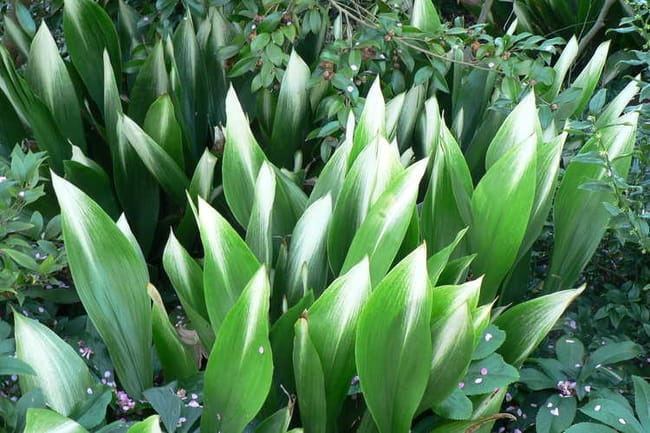
Aspidistra Elatior Variegata
This particular variety has yellow and white vertical stripes on the dark green leaves. There are a few of the leaves that will remain solid green in color.
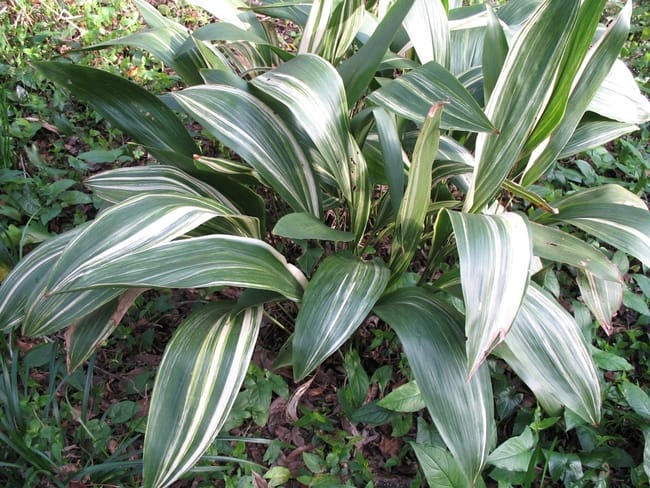
Aspidistra Elatior “Lennon’s Song”
The leaves of this particular variety will have light green to yellow vertical stripes down the center of the leaves. There are also some leaves that remain dark green in color.
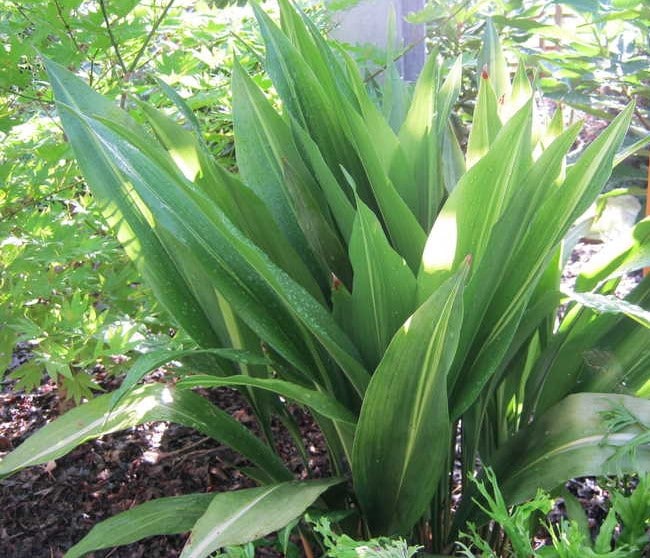
Cast Iron Plant Diseases And Pests
There are a few diseases and pests that you’ll want to be aware of in regards to your Aspidistra Elatior plant. We’ve listed the most common ones and given you some tips on how to deal with them below.
Leaf Blotch
Leaf blotch is identified by the brownish black spots that appear on the leaves. They will be various shapes and sizes and in the end, the leaves will fall off of the plant. These are caused by different types of fungi that infect the plants if they are weak.
To combat this, you’ll need to remove the leaves that are infected so that it won’t spread to the rest of the plant. There are different types of fungi so if you’re battling this, you’ll want to use a broad spectrum fungicide.
Mealy Bugs
Mealy bugs attack the plant and suck the juice out of the leaves. This, in turn, retards the growth of the plant and will eventually cause the plant to die. They are white and have a wool type of web that can cover the entire plant if the infestation is severe.
They are approximately five millimeters in length. Covered in a layer of wax that is cleverly designed to keep them from becoming prey to their enemies, the cause of this infestation is typically being exposed to air that is too dry or from a nearby heat vent or radiator. IT can also be introduced by another plant that may be infested.
To combat this infestation, first remove the plant from other nearby plants. Wipe the leaves with a damp cloth that has been dampened in rubbing alcohol. Repeat this every day until you no longer see the bugs. You can also use neem oil if you don’t have access to any rubbing alcohol.
Scale Insects
These sticky scaly insects will appear as a sticky honey on the leaves of the plant. They are brownish in appearance. The leaves will begin to turn brown and fall off of the plant. These should be treated as above however, they have a stronger outer shell and may be even more challenging to get rid of. You may have to resort to stronger chemicals to rid your plant of these creatures.
Spider Mites
If you see a web-like formation on your plant near the pointy edges of the leaves, you may have red spider mites. These are often due to air that is too dry and the room being too warm for the plant.
The leaves will have a shimmery silver appearance and they will eventually turn yellow and die. If you have an infestation, put the plant in a shower and wash away the spider mites, You may also have to resort to chemicals for this type of infestation.
Toxicity
The cast iron plant isn’t toxic to humans or to animals, including dogs, cats or horses.
Frequently Asked Questions About Cast Iron Plants
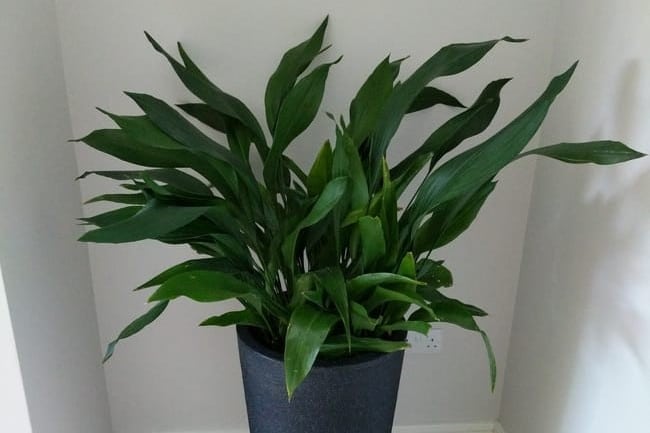
Do I need to avoid direct sunlight when positioning Cast Iron plants?
While this plant requires plenty of light (the variegated species requiring more light than it’s green cousin), direct sunlight can cause damage to the plant so you’ll want to make sure that your plant is in indirect sunlight or has a more filtered light source.
Can I place my Cast Iron plant outdoors in warmer weather?
Yes, during the warmer spring months through the warm fall you can place your Aspidistra Elatior plant on a protected balcony, patio, or in a garden area. Take great care, however, to ensure that your plant is back indoors before the first frost which could be very damaging to your plant. Also ensure that your Cast Iron plant has plenty of protection from direct rainfall.
Does the Aspidistra Elatior ever grow outdoors exclusively?
Yes, in many regions of the Southern United States, the Aspidistra Elatior grows carefree and takes over as a ground cover, this is especially true if it’s planted in a shady location.
Does the Aspidistra Elatior require any specialized care?
Patience is the key for caring for this plant. It’s an ideal plant for those who have a “brown thumb” and tend to kill off their houseplants unintentionally. It tolerates many conditions including dust, neglect, dim lighting, and occasional over watering.
Can Cast Iron plants tolerate cold?
While it’s not recommended, there have been reports of the plant tolerating temperatures as cold as 28°F without any serious damage.
Can I use this Cast Iron plant foliage in flower arrangements?
The Aspidistra Elatior makes an excellent addition to a flower arrangement. The foliage will last for several weeks.

